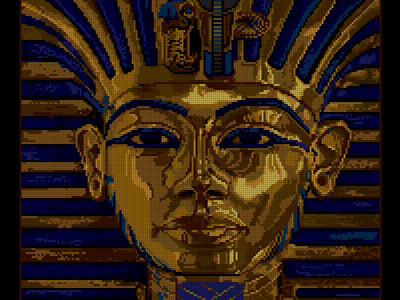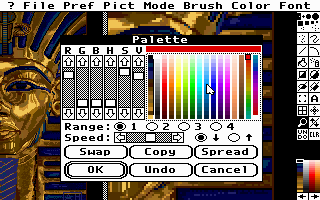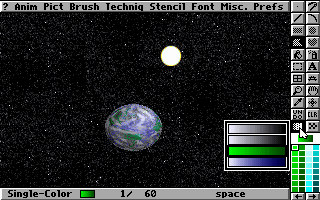
It must be hard for the younger generation to imagine what gaming was like in the 20th century. A case in point: up until the early 1990s, one of the main motivators for playing (or completing) new games was seeing new graphics. The amount of computer imagery being generated anywhere in the world at the time was very small, and floppy disks and ROM cartridges provided precious little space for purely decorative images (which were usually painstakingly hand-drawn). I distinctly remember the promise of perhaps a single, quarter-screen still image seeming like a fair reward for the hours of effort it took to complete most Sega Master System games.
It became a commercial imperative for developers to make sure that the limited amount of artwork in their games was as attractive as possible. Studios like The Bitmap Brothers and Psygnosis became famous for their visual style as much as for the content of their games. As a result there was great demand for a paint package that would allow artists to produce work quickly, efficiently and with the minimum of programming knowledge or intermediate steps. Probably the most successful and widely used package was Electronic Arts’s Deluxe Paint.
Deluxe Paint (colloquially known as ‘DPaint’) was available for the Amiga, Atari ST and DOS. (The PC versions still run happily under Windows XP.) It was used by many of the main development studios of the late 80s and early 90s. It was particularly heavily used by LucasArts (with all of their adventure games using it for the majority of their artwork prior 1997), as well as Origin (Wing Commander, Ultima) and of course Electronic Arts themselves. (The intro movies to several EA games including Space Hulk and The Lost Files of Sherlock Holmes were actually stored in DeluxePaint Animation format.)
Many previews of PC, Amiga and 16-bit console games in the magazines of the time included screenshots of sprite sheets being put together in DPaint. Another tell-tale sign that Deluxe Paint was used in a game’s development is the use of the package’s standard fonts. These were used in dozens of games where the artists couldn’t be bothered to draw a unique logo or typeface, for example Ecco Jr. and Dragon: The Bruce Lee Story.
Deluxe Paint had lots of features that made it well suited to producing game graphics. Pixel-level editing was very easy and intuitive, much more so than in Adobe Photoshop. The left mouse button drew in the foreground colour, and the right mouse button erased to the background colour. An irregularly-shaped part of an image could be picked up as a ‘brush’ (that’s where Guybrush Threepwood’s first name comes from) and scaled, rotated and stamped multiple times into the image. This setup made many common operations extremely quick to carry out. DPaint’s major shortcoming from a modern perspective is that it lacks the concept of layers, making it fiddly to temporarily move around and overlap objects.

Later versions allowed brushes to be manipulated in 3D space (useful for roughing out the perspective in scenes), and even to pick up multiple frame brushes (animbrushes) that worked like a flickbook that could be painted into an animated scene. It was this ability to easily duplicate animated sprites that led to the creation of the test animations that would be the inspiration for Lemmings.
In addition to drawing, DPaint had very powerful tools for managing the indexed colour palette. When games could only use 256 (or even 32 or 16) colours on screen, it was vital to be able to make sure that all the graphics were being created with the same assumptions about what colours would be available. DPaint also supported popular programmatic tricks like colour cycling. This was the method of rotating some of the colour indices in the palette, resulting in those colours being changed in the image. (Good examples of this effect are the campfire scene at the start of Monkey Island 2, the title screen of Defender of the Crown, and the waves on the beach in round six of Streets of Rage 2.)
There were also tools to chop images into grids (useful for making tile sheets), blur colours together, recolour areas (without changing their shading), and to add various cheesy-looking gradient fills (used extensively in Indiana Jones and the Fate of Atlantis). DeluxePaint Animation (the most widely-used PC version) even included a very rudimentary morphing feature, which can be seen in action in Monkey Island 2 when Guybrush’s parents ‘melt’ into dancing skeletons.

Deluxe Paint eventually fell out of favour as raytracing, digitisation and ultimately polygonal 3D reduced the importance of hand-drawn pixel art in games. During its heyday, it’s hard to estimate exactly how great an impact it had, although it’s difficult to imagine LucasArts’s more ambitious games having been possible from an art perspective without a de facto standard tool like DPaint having already been established. I think that it’s safe to say that DPaint was an innovation that expanded the boundaries of what was possible in the medium, in the same way that oil paint in tubes freed 19th Century artists from the studio, and digital video is currently democratising the film-making and editing process.
Addendum: As this post is celebrating an overlooked influence on game development, it’s also worth mentioning at least one of the most prolific artists who used it. Avril Harrison not only created the iconic Tutankhamun mask image (above) used to promote all versions of Deluxe Paint, but also contributed art to a diverse range of games including Prince of Persia, Toejam & Earl, Zombies Ate My Neighbours and both of the original Monkey Island games.
Tags: amiga, deluxe paint, deluxepaint animation, ea, graphics, PC, tools
